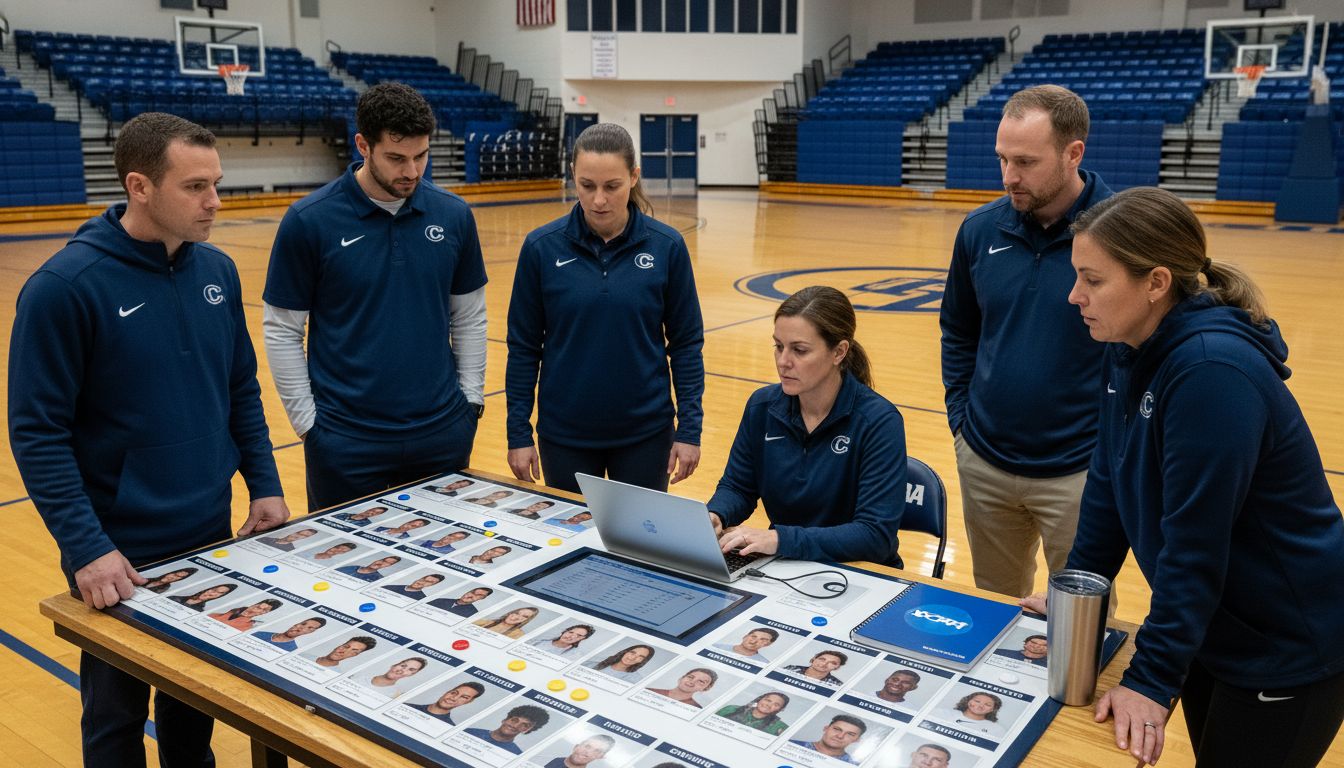Did you know that the average NBA team makes over 100 roster moves in a single season? Managing a basketball squad is much more than calling plays or scouting talent. Every coach and administrator faces the challenge of choosing the best lineup, maintaining team chemistry, and meeting strict eligibility rules. Understanding these roster strategies can shape a team’s success, highlight hidden talent, and keep everyone playing by the book.
Table of Contents
- Defining Basketball Roster Management
- Main Types of Rosters and Formats
- Key Roles and Responsibilities in Rosters
- Roster Formation, Rules, and Compliance
- Common Mistakes and Optimizing Your Roster
Key Takeaways
| Point | Details |
|---|---|
| Strategic Roster Management | Effective basketball roster management involves selecting and developing players to optimize team performance, taking into account individual skills and team dynamics. |
| Roster Format Understanding | Coaches must be familiar with different roster types (standard, tournament, developmental) to effectively align team structures with competitive objectives. |
| Roles in Roster Management | Clarity in the roles of coaches, administrators, and players is essential for successful roster development and compliance with eligibility requirements. |
| Avoiding Common Mistakes | Coaches should prioritize objective data analysis over biases and ensure flexibility in roster compositions to adapt to team changes. |
Defining Basketball Roster Management
Basketball roster management is the strategic process of selecting, organizing, and developing a team’s player lineup to maximize performance and competitive potential. According to research from Syracuse University, this critical coaching function involves carefully balancing player roles, performance metrics, and financial considerations to build a cohesive and competitive team.
At its core, roster management goes far beyond simply picking players. It requires deep understanding of each athlete’s unique strengths, potential skill development trajectory, positional needs, team chemistry, and how individual talents can be integrated into a unified strategic approach. Research from PubMed indicates that successful roster management involves sophisticated analysis of player skills, team dynamics, and potential performance optimization strategies.
Key components of effective basketball roster management include:
- Detailed player skill assessment
- Strategic position allocation
- Understanding individual and collective team potential
- Financial and salary cap considerations
- Long term player development planning
While the specifics might vary between professional, collegiate, and youth basketball, the fundamental goal remains consistent: constructing a team capable of achieving maximum competitive success by strategically leveraging available player talent.
 Learn more about building winning team strategies in our basketball playbook creation guide.
Learn more about building winning team strategies in our basketball playbook creation guide.
Main Types of Rosters and Formats
Basketball roster formats vary widely across different competitive levels and organizational structures, reflecting the unique needs of each basketball program. According to research from Boston University, rosters can range from standard team configurations to specialized tournament-specific and developmental team arrangements, each serving distinct strategic purposes.
In competitive basketball, roster types typically encompass several primary formats. Professional leagues like the NBA often maintain full rosters with active and reserve players, while collegiate and youth programs might implement more flexible structures. Research from Cyony indicates that different organizations implement specific roster limitations and eligibility criteria to ensure fair play and maintain competitive balance.
The main roster types include:
Here’s a summary of the main basketball roster types and their key purposes:
| Roster Type | Main Purpose | Typical Use Case |
|---|---|---|
| Standard Team Roster | Regular season competition | NBA, NCAA, high schools |
| Tournament Roster | Short-term competition | Playoffs, invitational events |
| Developmental Roster | Player growth & future talent | Youth, G-League, academies |
| Reserve/Practice Squad | Training support, emergencies | NBA reserves, college squads |
| Specialized Position Roster | Tactical match-ups or strategies | Defensive/offensive lineups |
- Standard Team Roster: Full complement of players for regular season play
- Tournament Roster: Limited players selected for specific competitions
- Developmental Roster: Focused on player growth and future potential
- Reserve/Practice Squad: Supporting players who train with the main team
- Specialized Position Rosters: Tailored to specific tactical approaches
Coaches must understand these roster formats to strategically build teams that maximize player potential and organizational objectives.
Key Roles and Responsibilities in Rosters
Basketball roster management involves complex interactions between multiple key stakeholders, each playing a critical role in team organization and performance. According to the NCAA, coaches bear primary responsibility for submitting accurate team rosters and ensuring strict compliance with player eligibility requirements.
The primary roles in roster management typically include:
- Head Coach: Overall strategic roster development
- Assistant Coaches: Player evaluation and skill assessment
- Team Administrators: Eligibility verification and roster documentation
- Team Captains: On-court leadership and team cohesion
- Player Personnel Managers: Tracking player statistics and performance metrics
According to the Ohio High School Athletic Association, administrators play a crucial oversight role, verifying player eligibility and maintaining competitive balance across team rosters. This involves detailed documentation, tracking player transfers, and ensuring all regulatory requirements are met throughout the season.
Beyond formal roles, successful roster management requires collaborative communication and a shared commitment to team objectives. Learn more about developing leadership skills within your basketball team with our guide on team captain responsibilities.
Roster Formation, Rules, and Compliance
Roster formation is a critical process governed by stringent rules and compliance requirements that ensure fair competition and team integrity. According to the NCAA, teams must provide comprehensive player information and strictly adhere to detailed eligibility criteria for participation in official events.
Key compliance considerations for roster management include:
- Detailed Player Documentation: Complete personal and athletic information
- Eligibility Verification: Academic, age, and performance requirements
- Transfer Regulations: Tracking player movement between teams
- Academic Standing: Maintaining minimum academic performance standards
- Medical Clearance: Health and fitness documentation
The Ohio High School Athletic Association emphasizes that competitive balance depends on meticulous roster data collection and adherence to established guidelines. This involves not just collecting information, but ensuring that every aspect of roster composition meets the prescribed standards of fairness and transparency.
Successful roster compliance requires proactive management, clear communication, and a systematic approach to documentation. Coaches must stay informed about evolving regulations and implement robust tracking systems. Learn more about managing team dynamics and potential conflicts with our guide on handling team interactions.
Common Mistakes and Optimizing Your Roster
Roster optimization is a nuanced process that requires strategic thinking and data-driven decision-making. Research from Syracuse University highlights that successful roster construction involves carefully analyzing player types, performance statistics, and financial constraints to build a competitive team.
Common mistakes coaches frequently make in roster management include:
- Subjective Player Selection: Relying on personal bias instead of objective metrics
- Overlooking Team Chemistry: Focusing solely on individual player skills
- Ignoring Performance Data: Neglecting comprehensive statistical analysis
- Inflexible Roster Structures: Failing to adapt to changing team dynamics
- Budget Mismanagement: Poor allocation of financial resources
According to research published in PubMed, the most effective roster strategies prioritize objective selection methods over subjective assessments. This means moving beyond gut feelings and implementing a systematic approach to player evaluation that considers multiple performance indicators, potential for growth, and overall team balance.
Successful roster optimization requires continuous learning and adaptability. Coaches must develop a holistic view of team composition, balancing individual talents with collective potential. Discover strategies for improving player development with our guide on key coaching tips.
Take Control of Your Basketball Roster Management Today
Managing a basketball roster involves making tough decisions about player selection, balancing skills with team chemistry, and navigating complex eligibility rules. If you find yourself overwhelmed by subjective choices or struggling to optimize your lineup for peak performance, you are not alone. The right tools can transform your approach from guesswork into a clear, strategic process.

Discover how our professional Basketball Templates can help you organize your roster, track key player metrics, and comply with important rules. With resources crafted from real coaching experience, Hoop Mentality empowers you to save time, improve communication, and focus on developing winning teams. Don’t wait to build your best roster. Visit Hoop Mentality now and take your coaching to the next level.
Frequently Asked Questions
What is basketball roster management?
Basketball roster management is the strategic process of selecting, organizing, and developing a team’s player lineup to maximize performance and competitive potential through careful assessment of player roles, skill development, and team dynamics.
What are the main types of basketball rosters?
The main types of basketball rosters include standard team rosters for regular season play, tournament rosters for specific events, developmental rosters for player growth, reserve/practice squads for training support, and specialized position rosters for tactical match-ups.
What are common mistakes in basketball roster management?
Common mistakes in basketball roster management include subjective player selection, overlooking team chemistry, ignoring performance data, having inflexible roster structures, and mismanagement of budgets, leading to potential inefficiencies in team composition.
What are key compliance considerations in roster management?
Key compliance considerations in roster management involve detailed player documentation, eligibility verification, transfer regulations, maintaining academic standing, and ensuring medical clearance to uphold competitive integrity.

